A lake is a large body of water that has no direct sea connection. The size and depth of the lake varies with respect to pond. In this case, limnology plays crucial role to know the basic characteristics of the lake. The lymphatic and profound regions increase in size than the litoral regionof the lake.
Different scientists have defined lakes in different ways. Some of the important definitions are given below:
- According to Forrell (1892), a lake is a body of standing water with a basin for holding water and no connection to the sea. He called the shallow lake as a pond.
- According to Mutkosir (1917), lakes are those bodies of still water that are relatively large and deep enough to be thermally stratified.
- According to Hutchinson (1956), lakes are created by natural disasters and gradually disappear. Many lakes have been created by earthquakes and volcanic eruptions during the Ice Age.
According to the Hydrology book, a lake will have the following five characteristics, viz-
- It consists of one or more basins, partially or completely connected to each other.
- All parts of the lake will have the same water level (except for the effects of wind, ice cover and incoming rainfall).
- The lake usually does not have access to sea water.
- A significant portion of the sediment suspended in the water will accumulate at the bottom of the lake.
- The average water volume of a lake must exceed a certain limit (e.g. more than 1 hectare).
Lakes Distribution
Lakes cover about 1.6% (2.5×106 km) of land. The total water stored in all the lakes is about 2.6 x 105 km3. 20% of which is in Lake Baikal. The largest lake in the world is the Caspian Sea.
Most of the world’s lakes are freshwater and most are located in the northern hemisphere of high latitudes. There are 31,752 lakes in Canada`s drainage system, each larger than 3 km (1.2 sq mi). Finland has 187888 lakes, of which 56,000 are large (1000 sq km). Most lakes have been created for artificial and hydroelectric generation, for decoration, recreation, industrial use, agricultural use, or for domestic water supply. There are 304 million stagnant water bodies worldwide. 91% of the lake is 1 hectare (2.5 acres) or less. Smaller lakes are more numerous than large lakes.
Lake Size
Lakes come in different sizes. However, in all cases it is larger than the pond (Table-). The world’s largest freshwater lake is Lake Superior with an area of 82,414 square kilometers. The Caspian Sea, on the other hand, has an area of 371,000 square kilometers. Sometimes it is considered as a lake. During the rainy season, Lake Moon in Africa covers an area of 40,000 square miles, and during the dry season, it reaches 6,000 square miles. There are several large lakes on each continent.
Depth of Lake
The depth of the lake also varies greatly. The depth of the deepest lake is much less than the sea. Lake Baikal in southern Siberia has a maximum depth of about 1,637 meters.
The depth of Greater Lake in Oregon, North America, is about 608 meters. Lake Superior has a depth of 406 meters, but most lakes are less than 30 meters deep.
Classification of Lake
There are two types of lakes based on geography and circulation patterns, viz-
1. Polar lakes: The surface temperature of this lake never falls below 40C.
2. Lakes in temperate regions: The surface temperature of the lake varies above and below 40C. The bottom temperature maintains circulation in all seasons like the surface.
Classification of lakes based on temperature cycles and stratification:
1. Amictic: Permanently frozen and always below 40C. There is never any circulation.
2. Cold monomictic: The water at any depth never rises above 40C. Circulation occurs independently in summer and the temperature stays below 40C.
3. Dimictic: In spring the lake also has full circulation. At this time the water temperature is 40C. Stays on top of it. Layering occurs in summer and mixed again in autumn. At this time the lake is cold.
4. Warm monomictic: The water temperature at any level is never below 40C. Circulation occurs independently in winter or directly above 400C in summer.
5. Oligomictic: Such lakes are located in very warm areas. Water temperature is always above 40C and permanent stratification is normal. As a result of the flow of air, this stratification is soon broken. Such lakes are found in humid tropical regions.
6. Polymictic: Mixtures occur continuously but only at low temperatures (just above 40C). There is no thermal stratification.
You might also read: Lake Morophology and Morhometry
Trophic Classification of Lake
Scientists are working tirelessly to determine useful multiparameter indicators to describe the normal state of a reservoir. Trophic conditions refer to all the versatile parameters that are used to describe the quality of water on the surface of a lake. The lake can be divided into several levels based on the trophic level.
Trophic conditions indicate the biological productivity of the lake. Different trophic classes include Trophic Index (TI), Chlorophyll (Chl), Phosphorus (P) and microorganisms per liter, Sekkidisk Depth (SD), and Trophic Class (Carlson, 1996). In this case, the lake is divided into three classes namely:
- Oligotrophic,
- Mesotrophic and
- Eutrophic.
|
Trophic Index(TI) |
Chlorophyll(Chl) |
Phosphorous (P) |
Secci Disc(SD) |
Trophic Class |
|---|---|---|---|---|
|
<30—40 |
0—2.6 |
0—12 |
>8—4 |
Oligotrophic |
|
40—50 |
2.6—20 |
12—24 |
4—2 |
Mesotrophic |
|
50—70 |
20—56 |
24—96 |
2—0.5 |
Eutrophic |
|
70—100+ |
56—155+ |
96—384+ |
0.5—<0.25 |
Hypereutrophic |
1. Oligotrophic lake
Oligotrophic lake has low initial productivity due to low nutrient content. Such lakes produce low levels of algae, so the water is often very clear and high in drinkable water. The bottom water of such lakes contains a lot of oxygen, so the lake has a lot of fish species such as trout. Deep lakes are high in oxygen due to their large high-polymonetic volume.
Ecologists use the term oligotrophic to refer to non-productive lakes. Such lakes are deficient in nutrients. Eutrophic lakes, on the other hand, are rich in nutrients. Oligotrophic lakes are more common in wintering regions. This lake also has resistant volcanoes at the bottom.
Some of the important features of Oligotrophic Lakes are mentioned below:
- It is a very deep lake.
- Thermocline levels are high.
- The area of the Hypolimonion region is large and the water in that region is cool.
- Organic matter and degraded material are present in very small quantities at the bottom.
- Electrolyte may be low or varied.
- Calcium, phosphorus and nitrogen are relatively low.
- Humorous objects are scarce or absent.
- At all depths there is a high level of dissolved oxygen throughout the year.
- It does not contain enough large aquatic plants.
- The amount of plankton is limited but the number of species is large.
- Boom is rarely seen in water.
- This lake has the highest number of Chlorophyceae.
- Rich in deep and cool water fish (salmon, cisco and trout).
- It can turn into a eutrophic lake.
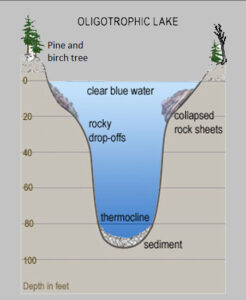
2. Mesotrophic Lake
Meso means medium or mesotrophic means moderate amount of nutrients (phosphorus and nitrogen). The water of such lakes is clear, with aquatic plants submerged at the bottom and some algae blooms at the end of summer. Such lakes are found in large quantities in central Minnesota. Such lakes are home to large fish such as walleye, perch, smallmouth bass, muskellunge and northern pike.
In such lakes, the upper layer of water is heated by the heat of the sun and contains a lot of algae, so there is a lot of oxygen in the upper layer. The bottom is usually cold and in the middle of summer, algae and other organisms die during this time, which reduces the amount of oxygen. Due to this, fish and other creatures move from the bottom to the shallow areas with oxygen.
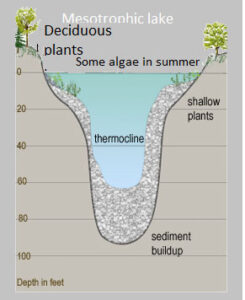
3. Eutrophic Lakes
The word eutrophic is derived from the Greek ‘eutrophos’ which means rich in nutrients. Such lakes have high biological productivity. Due to the high nutrient content, especially the abundance of nitrogen and phosphorus, it is helpful for a large number of aquatic organisms to grow. Water is usually rich in aquatic plants or algae. Such lakes are more common in Southern Minnesota. Such lakes are relatively shallow and contain sufficient amounts of organic matter at the bottom. The amount of electrolyte varies.
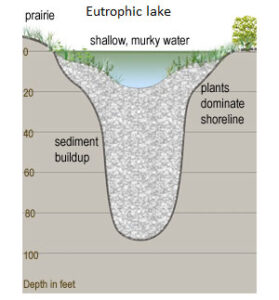
Adequate amounts of calcium, phosphorus and nitrogen but low levels of humic acid. Plankton is also abundant in this lake. However, the quality varies. Algal bloom in water is usually seen. Myxophyceae and Diatom are abundant. There are a small number of profound species (such as Chironomus, Corethera) in the hypolimonic layer of such deep stratified lakes. There are no fish in the deep waters of this lake, but perch, pike, bass, and other warm water fish are found. Gradually the lakemay turn into weedy muddy wetlands.
4. Hypereutrophic Lakes
These lakes are rich in nutrients. Excessive algae blooms are often seen and clarity is low. Even in such lakes the visible depth is less than 3 meters and the amount of chlorophyll per liter of water is 40 micrograms and the amount of phosphorus is more than 100 micrograms. Excessive algal blooms significantly reduce oxygen levels, resulting in a low-depth death zone beneath the surface of such a reservoir, which reduces the density of the organism.
5. Dystrophic Lakes
Dystrophic lakes are rich in humic substances and organic acids, so the water is usually brown or tea-colored. Such lakes are termed as acidic and low nutrient rich lakes. There is a lot of variation in the pH value and productivity of this lake. It is usually shallow, in the vicinity of the bog or near the cool mountains.
The bottom of the lake contains sufficient amount of organic and dehydrated matter and less amount of electrolyte. In addition, the amount of calcium, phosphorus and nitrogen is very low. Deep water in most cases does not contain dissolved oxygen. Larger aquatic plants are also less observed and plankton varies.
Quantitatively Myxophyceae are more numerous. Profundal microflora is present in small amounts or absent. Sometimes benthos such as Chironomus, Corethera type animals exist. Cold water fish are always absent in such lakes. Sometimes the fish do not stay at all. Fish production is also generally low. Such lakes are found in North America and Eurasia. An example of such a lake is a lake of South Georgia.
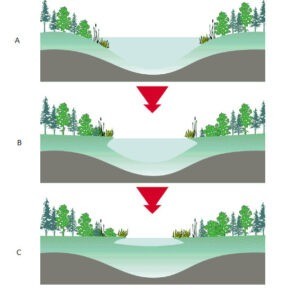
Image Showing Succession of the lake- (a) Oligotrophic; (b) Mesotrophic and (c) Eutrophic lakes
Lake Classificatiion By Naumann (1929)
|
Lake types |
Characteristics |
|---|---|
|
Oligotrophy |
Low nitrogen and phosphorus production is low. |
|
Eutrophy |
Production is very high due to high levels of nitrogen and phosphorus. |
|
Acidotrophy |
pH value below 5.5 and low productivity. |
|
Alkalitrophy |
Highly calcium rich and low productivity. |
|
Argillotrophy |
Presence of excessive clay particles and low productivity. |
|
Siderotrophy |
Excessive iron presence and low productivity. |
|
Dystrophy |
Presence of excessive humic color and low productivity. |
You might also read: Ponds and its Types
Life Span of Lake
Like other objects, lakes change over time. Even a human-like, lake has a lifespan such as immature lakes, middle-aged lakes and ancient lakes. Many lakes in British Columbia are still completely immature as they were formed during the last ice age. Many lakes are slowly shrinking. The lake gradually shrinks as there is natural land on the shores of the lake. Every year leaves fall from trees and shrubs on the shores of the lake and accumulate at the bottom of the lake. The debris of this herb gradually decomposes to create new habitats for grasses and hogla plants.
Grasses spread their roots quickly and create stable new fields for dry land species. In places where water lilies grow once, sometimes shrubs and small plants grow. If the lake is too small, it will not be able to provide enough oxygen and food for some fish. However, this happens so slowly that the fish have enough time to move to another lake. In this case, the lakes are connected to other lakes by small water flows. Succession of organisms did not occur in all types of lakes. In the case of steep and rocky arrows, the fish cannot crawl to the top in a short time.
Death of the Lake
Once a lake is formed, it dies. Sediment accumulates in the basins of lakes and eventually dies. The elements float elsewhere through air flow and erosion and fall into the lake and the various elements of the lake are stored as sediment at the bottom. Over time it turned into swamps, muddy lands and forests. Some lakes are so deep that it takes millions of years for them to fill up.
The following table describes the important lakes of the world:
|
Name of Lake |
Area |
Length |
Maximum Depth |
Water Volume |
Comments |
|---|---|---|---|---|---|
|
Caspian Sea |
371,000 km2 (143,000 sq mi) |
1,199 km (745 mi) |
1,025 m (3,363 ft) |
78,200 km3 (18,800 cu mi) |
It is often regarded as the largest lake of the world. |
|
Superior |
82,100 km2 (31,700 sq mi) |
616 km (383 mi) |
406.3 m (1,333 ft) |
12,100 km3 (2,900 cu mi) |
It is the largest freshwater lake in the world by surface area. |
|
Victoria |
68,870 km2 (26,590 sq mi) |
322 km (200 mi) |
84 m (276 ft) |
2,750 km3 (660 cu mi) |
It is the largest lake in Africa. by area. |
|
Huron |
59,600 km2 (23,000 sq mi) |
332 km (206 mi) |
229 m (751 ft) |
3,540 km3 (850 cu mi) |
It is the world’s largest lake island. |
|
Michigan |
58,000 km2 (22,000 sq mi) |
494 km (307 mi) |
281 m (922 ft) |
4,900 km3 (1,200 cu mi) |
It is the largest lake (by area).which is located in USA. |
|
Tanganyika |
32,600 km2 (12,600 sq mi) |
676 km (420 mi) |
1,470 m (4,820 ft) |
18,900 km3 (4,500 cu mi) |
It is the longest freshwater lake in the world and second-largest lake by volume. |
|
Baikal |
31,500 km2 (12,200 sq mi) |
636 km (395 mi) |
1,637 m (5,371 ft) |
23,600 km3 (5,700 cu mi) |
It is the deepest lake in the world and largest volume freshwater lake in the world. |
|
Great Bear Lake |
31,000 km2 (12,000 sq mi) |
373 km (232 mi) |
446 m (1,463 ft) |
2,236 km3 (536 cu mi) |
It is ther largest lake in Canada. |
|
Malawi |
29,500 km2 (11,400 sq mi) |
579 km (360 mi) |
706 m (2,316 ft) |
8,400 km3 (2,000 cu mi) |
It contains more fish species of fish than any other lake in the world |
|
Great Slave Lake |
27,000 km2 (10,000 sq mi) |
480 km (300 mi) |
614 m (2,014 ft) |
1,560 km3 (370 cu mi) |
It is the deepest lake in North America |
|
Erie |
25,700 km2 (9,900 sq mi) |
388 km (241 mi) |
64 m (210 ft) |
489 km3 (117 cu mi) |
|
|
Winnipeg |
24,514 km2 (9,465 sq mi) |
425 km (264 mi) |
36 m (118 ft) |
283 km3 (68 cu mi) |
|
|
Ontario |
18,960 km2 (7,320 sq mi) |
311 km (193 mi) |
244 m (801 ft) |
1,639 km3 (393 cu mi) |
|
|
Ladoga |
18,130 km2 (7,000 sq mi) |
219 km (136 mi) |
230 m (750 ft) |
908 km3 (218 cu mi) |
|
|
Balkhash |
16,400 km2 (6,300 sq mi) |
605 km (376 mi) |
26 m (85 ft) |
106 km3 (25 cu mi) |
|
|
Bangweulu |
15,100 km2 (5,800 sq mi) |
75 km (47 mi) |
4 m (13 ft) |
|
|
|
Vostok |
12,500 km2 (4,800 sq mi) |
250 km (160 mi) |
900–1,000 m (3,000–3,300 ft) |
5,400 ± 1,600 km3 (1,300 ± 380 cu mi) |
It is the largest lake in Antarctica. |
|
Onega |
9,700 km2 (3,700 sq mi) |
245 km (152 mi) |
127 m (417 ft) |
285 km3 (68 cu mi) |
|
|
Titicaca |
8,372 km2 (3,232 sq mi) |
177 km (110 mi) |
281 m (922 ft) |
893 km3 (214 cu mi) |
It is the highest navigable lake in the world and largest lake in South America. |
|
Nicaragua |
8,264 km2 (3,191 sq mi) |
177 km (110 mi) |
26 m (85 ft) |
108 km3 (26 cu mi) |
|
|
Athabasca |
7,850 km2 (3,030 sq mi) |
335 km (208 mi) |
243 m (797 ft) |
204 km3 (49 cu mi) | Cell |
|
Taymyr |
6,990 km2 (2,700 sq mi) |
250 km (160 mi) |
26 m (85 ft) |
12.8 km3 (3.1 cu mi) |
It is the largest lake in Arctic Circle. |
|
Turkana |
6,405 km2 (2,473 sq mi) |
248 km (154 mi) |
109 m (358 ft) |
204 km3 (49 cu mi) |
It is the largest permanent desert lake and the world’s largest alkaline lake. |
|
Reindeer Lake |
6,330 km2 (2,440 sq mi) |
245 km (152 mi) |
337 m (1,106 ft) |
95.25 km3 (22.85 cu mi) |
|
|
Issykkul |
6,200 km2 (2,400 sq mi) |
182 km (113 mi) |
668 m (2,192 ft) |
1,738 km3 (417 cu mi) |
|
|
Urmia |
6,001 km2 (2,317 sq mi) |
130 km (81 mi) |
16 m (52 ft) |
|
|
|
Vanern |
5,545 km2 (2,141 sq mi) |
140 km (87 mi) |
106 m (348 ft) |
153 km3 (37 cu mi) |
It is the largest lake in the European Union. |
|
Winnipegosis |
5,403 km2 (2,086 sq mi) |
245 km (152 mi) |
18 m (59 ft) |
|
|
|
Albert |
5,299 km2 (2,046 sq mi) |
161 km (100 mi) |
58 m (190 ft) |
280 km3 (67 cu mi) |
|
|
Mweru |
5,120 km2 (1,980 sq mi) |
131 km (81 mi) |
27 m (89 ft) |
38 km3 (9.1 cu mi) |
|
|
Nettilling |
5,066 km2 (1,956 sq mi) |
113 km (70 mi) |
132 m (433 ft) |
|
It is the largest lake in Baffin island |
|
Nipigon |
4,843 km2 (1,870 sq mi) |
116 km (72 mi) |
165 m (541 ft) |
248 km3 (59 cu mi) |
|
|
Manitoba |
4,706 km2 (1,817 sq mi) |
225 km (140 mi) |
7 m (23 ft) |
14.1 km3 (3.4 cu mi) |
|
|
Qinghai Lake |
4,489 km2 (1,733 sq mi) (2007) |
32.8 m (108 ft) |
|
|
|
|
Saimaa |
≈ 4,400 km2 (1,700 sq mi) |
82 m (269 ft) |
36 km3 (8.6 cu mi) |
|
|
|
Lake of the Woods |
4,350 km2 (1,680 sq mi) |
110 km (68 mi) |
64 m (210 ft) |
19.4 km3 (4.7 cu mi) |
|
|
Khanka |
4,190 km2 (1,620 sq mi) |
90 km (56 mi) |
10.6 m (35 ft) |
18.3 km3 (4.4 cu mi) |
|
|
Sarygamysh |
3,955 km2 (1,527 sq mi) |
125 km (78 mi) |
40 m (130 ft) |
68.56 km3 (16.45 cu mi) |
|
|
Van |
3,755 km2 (1,450 sq mi) |
119 km (74 mi) |
451 m (1,480 ft) |
607 km3 (146 cu mi) |
|
|
Peipus |
3,555 km2 (1,373 sq mi) |
15.3 m (50 ft) |
25 km3 (6.0 cu mi) |
|
|
|
Poyang |
3,210 km2 (1,240 sq mi) |
170 km (110 mi) |
25.1 m (82 ft) |
25.2 km3 (6.0 cu mi) |
|
Data Source: wikipedia
Origin/Formation of Natural Lakes
Lakes are created by geological, climatic, biological and supernatural techniques, especially catastrophes and other techniques.
1. Tectonic Lakes: Long-lived lakes are associated with the tectonic process, with volcanic eruptions forming valleys in mountain ranges, and water accumulation in the basin to form the lake. Superior lakes are formed by both gaseous and tectonic processes.
2. Landslide and ice-dam Lakes: Landslide and ice-dam lakes: Such lakes are formed as a result of freezing snow or landslides. Snow plays a role in creating lakes in a variety of ways, such as:
- By basin excavation;
- The formation of lakes occurs due to the accumulation of large amounts of ice melt water due to temperature differences.
- Due to the action of snow, lakes are formed due to the accumulation of water in the deep valleys of the world. Many lakes were formed by the flow of snow when the state of Washington in the United States was formed during the last ice age. During this time the ice melts and floods occur. Later it dried up and formed a lake. This is how Lake San in Washington was created.
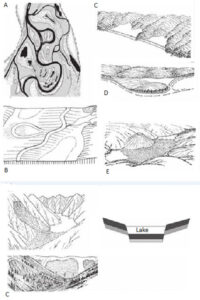
Image: Lake formation process and morphological features: (a) Different types of floodplain lakes; (b) Horse-shaped lake formation; (c) Creation of lakes by removal of silt and construction of dams; (F) Lakes formed by changes in the position of tectonic plates
3. Salt Lake: Lakes that do not have an outlet or where water evaporates rapidly and the salt concentration at the bottom of the drainage column is higher than the normal salt concentration. Such as the Great Lake, Aral Lake and the Dead Sea.
4. Oxbow Lakes: Such lakes are small in size and half crescent-shaped. As a result of the change in the course of the river, such lakes are formed. Over time an equine curve is formed. The river separates along the narrow neck. A new course is made for the river and at the end the bend is filled with silt to form a bow-shaped lake.
5. Crater Lakes: Such lakes are formed by sedimentation of dead volcanic craters or circular basins (caldares). Such as Volcano Lake in Oregon and Caldera Lake in Mount Mazama. Lake Caldera is the result of massive volcanic eruptions. Mount Mazama was formed about 4860 years ago.
6. Glacial Lakes: Such lakes are formed by the accumulation of water in the dead glaciers. Such lakes can be seen in Scandinavia, Patagonia, Siberia and Canada. A more notable example is the Great Lakes of North America. In special cases, gloe lakes are formed from the sea in the post-glacial period and are filled with fresh water.
7. Other Lakes: Some lakes, such as Lake Jackson in Florida, have been created by sinkhole activity. Lake Vostok in Antarctica is a self-glacial lake. It is also the largest lake in the world.
Besides these, a lake is formed as follows, viz-
- Through landslides in eroded valleys.
- By melting rocks (limestone) after the surface is submerged.
- Through earthquakes.
- From the extinct volcanic crater.
- Horse-shaped lakes are formed by changing the course of various activities of the river. The lake is formed by closing the mouth at the place of origin of the Shadha branch. There are such horse-shaped lakes in the south-western part of Bangladesh, such as Baluhar, Joydia, etc.
You might also read: Distribution of Plankton
